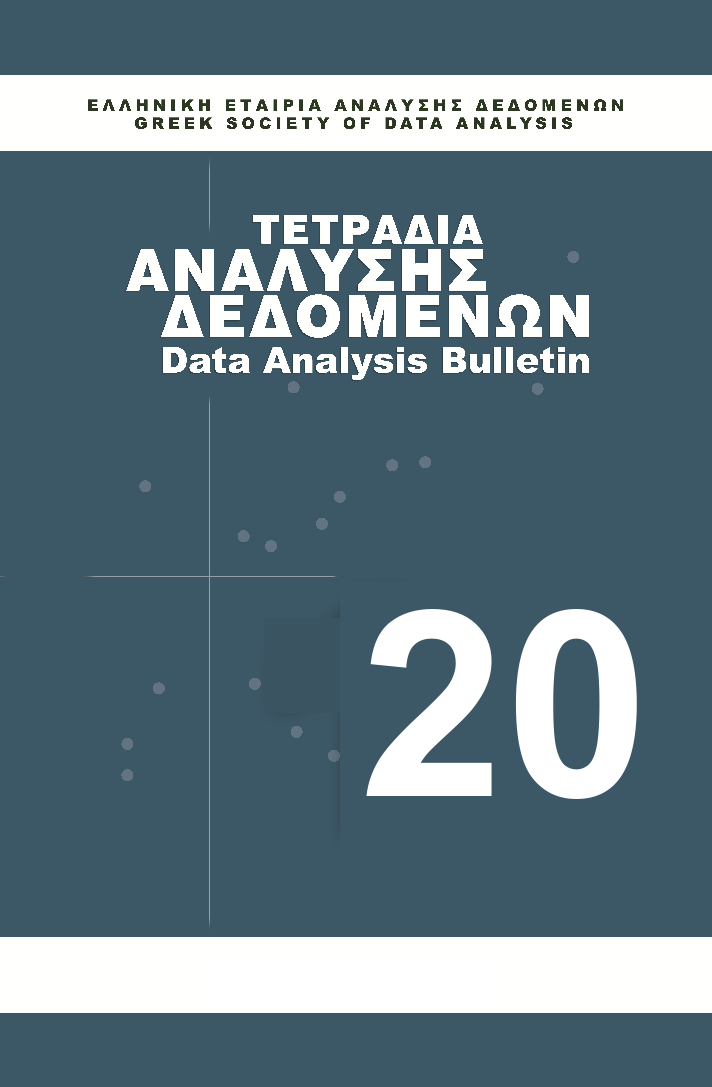Στρατηγικές νοερής επίλυσης γραφικών έργων με συναρτήσεις, μαθητών Γ΄ Λυκείου: Στρατηγική ανάλυσης περιεχομένου συνεντεύξεων με μεθόδους της Ανάλυσης Δεδομένων

Περίληψη
Στην παρούσα εργασία παρουσιάζεται μεθοδολογικό σχήμα χρήσης μεθόδων της Ανάλυσης Δεδομένων (AFC, HCA, Biplot Analysis, Kriging Interpolation) για την επεξεργασία δεδομένων λόγου, τα οποία συλλέχθηκαν μέσω κλινικής συνέντευξης από 42 μαθητές Γ΄ Λυκείου, που αφορούσαν τις απαντήσεις τους σε εννέα γραφήματα δύο συναρτήσεων (γραμμικής-σταθερής ή τετραγωνικής-σταθερής ή δύο γραμμικές) και ζητούνταν να βρεθεί νοερά το αποτέλεσμα του αθροίσματος ή της διαφοράς τους. Η ανάλυση των ευρημάτων έδειξε, ότι οι μαθητές κατά τη νοερή επίλυση έργων με συναρτήσεις (γραμμικές\τετραγωνικές) ανέπτυξαν άλλοτε αλγεβρικές/παραμετρικές στρατηγικές, άλλοτε γραφικές/γεωμετρικές και άλλοτε γραφικές/αριθμητικές ή συνδυασμό αυτών. H επιλογή στρατηγικής εξαρτάται τόσο από τα χαρακτηριστικά του μαθητή (γνώσεις, προτιμήσεις, εμπειρία), όσο και τη φύση του έργου. Σε έργα με γραμμικές συναρτήσεις, οι μαθητές επέλεξαν κατά σημεία προσεγγίσεις, αλγεβρικές-αριθμητικές ή συνδυασμό τους, ενώ σε έργα με καμπύλες επέλεξαν ολιστικές προσεγγίσεις, γραφικές-γεωμετρικές. Επίσης, οι μαθητές με καλύτερη επίδοση στα μαθηματικά, έδειξαν μεγαλύτερο βαθμό ευελιξίας στις στρατηγικές που χρησιμοποίησαν και είχαν περισσότερες επιτυχίες. Μέσω της AFC αναδείχθηκε κυρίως η αντίθεση μεταξύ των κατά σημείων προσεγγίσεων και των ολιστικών προσεγγίσεων καθώς και η αντίθεση μεταξύ των συνδυαστικών στρατηγικών γραφική/γεωμετρική-αριθμητική και γραφική/γεωμετρική-αλγεβρική. Η μέθοδος της χωρικής παρεμβολής Ordinary Kriging χρησιμοποιήθηκε για την προβολή των ποσοστών επιτυχίας των μαθητών στις στρατηγικές και το αποτέλεσμα της παρεμβολής με τη μορφή χάρτη με ισοκαμπύλες προβλήθηκε στο παραγοντικό επίπεδο της AFC.
Λεπτομέρειες άρθρου
- Πώς να δημιουργήσετε Αναφορές
-
Παπαφιλίππου Ν., Κουτσός Θ., Μάρκος Ά., & Μενεξές Γ. (2024). Στρατηγικές νοερής επίλυσης γραφικών έργων με συναρτήσεις, μαθητών Γ΄ Λυκείου: Στρατηγική ανάλυσης περιεχομένου συνεντεύξεων με μεθόδους της Ανάλυσης Δεδομένων. Τετράδια Ανάλυσης Δεδομένων, 20(1), 95–108. ανακτήθηκε από https://ejournals.epublishing.ekt.gr/index.php/dab/article/view/33715
- Ενότητα
- Εμπειρικές μελέτες

Αυτή η εργασία είναι αδειοδοτημένη υπό το CC Αναφορά Δημιουργού – Μη Εμπορική Χρήση – Όχι Παράγωγα Έργα 4.0 4.0.
Οι Συγγραφείς που δημοσιεύουν εργασίες τους στο περιοδικό ΤΕΤΡΑΔΙΑ ΑΝΑΛΥΣΗΣ ΔΕΔΟΜΕΝΩΝ συμφωνούν στους παρακάτω όρους:
- Οι Συγγραφείς δεν χρεώνονται με έξοδα υποβολής, επεξεργασίας ή δημοσίευσης των εργασιών τους. Τα κόστη αυτά καλύπτονται από την Ελληνική Εταιρία Ανάλυσης Δεδομένων.
- Τα πνευματικά δικαιώματα των εργασιών που δημοσιεύονται στο περιοδικό ΤΕΤΡΑΔΙΑ ΑΝΑΛΥΣΗΣ ΔΕΔΟΜΕΝΩΝ προστατεύονται από την άδεια Creative Commons Attribution-NonCommercial-ΝοDerivatives 4.0 International. Οι Συγγραφείς διατηρούν τα Πνευματικά Δικαιώματα και χορηγούν στο περιοδικό το δικαίωμα της πρώτης δημοσίευσης. Η άδεια αυτή επιτρέπει σε τρίτους - αποδέκτες της άδειας να χρησιμοποιούν την εργασία σε οποιαδήποτε μορφή μόνο για μη εμπορικούς σκοπούς. Αν οι τρίτοι τροποποιήσουν ή προσαρμόσουν το περιεχόμενο, οφείλουν να κοινοποιήσουν το τροποποιημένο περιεχόμενο for noncommercial purposes only. If others modify or adapt the material, they must license the modified material under identical terms.
- Με την προϋπόθεση της διατήρησης των διατυπώσεων που προβλέπονται στην άδεια σχετικά με την αναφορά στον αρχικό δημιουργό και την αρχική δημοσίευση στο περιοδικό ΤΕΤΡΑΔΙΑ ΑΝΑΛΥΣΗΣ ΔΕΔΟΜΕΝΩΝ.
- Οι Συγγραφείς μπορούν να συνάπτουν ξεχωριστές και πρόσθετες συμβάσεις και συμφωνίες για τη μη αποκλειστική διανομή της εργασίας όπως δημοσιεύτηκε στο περιοδικό ΤΕΤΡΑΔΙΑ ΑΝΑΛΥΣΗΣ ΔΕΔΟΜΕΝΩΝ (π.χ. κατάθεση σε ακαδημαϊκά καταθετήρια), με την προϋπόθεση της αναγνώρισης και την αναφοράς της πρώτης δημοσίευσης στο περιοδικό ΤΕΤΡΑΔΙΑ ΑΝΑΛΥΣΗΣ ΔΕΔΟΜΕΝΩΝ.
- Το περιοδικό ΤΕΤΡΑΔΙΑ ΑΝΑΛΥΣΗΣ ΔΕΔΟΜΕΝΩΝ Α επιτρέπει και ενθαρρύνει τους συγγραφείς να καταθέτουν τις εργασίες τους σε θεσμικά (π.χ. το αποθετήριο του Εθνικού Κέντρου Τεκμηρίωσης) ή θεματικά αποθετήρια, μετά τη δημοσίευσή τους στο ΤΕΤΡΑΔΙΑ ΑΝΑΛΥΣΗΣ ΔΕΔΟΜΕΝΩΝ και με όρους Ανοικτής Πρόσβασης, όπως κατά περίπτωση προσδιορίζονται από τους χρηματοδότες της έρευνάς τους ή/και τα ιδρύματα με τα οποία συνεργάζονται. Κατά την κατάθεση της εργασίας τους, οι συγγραφείς πρέπει να παρέχουν πληροφορίες σχετικά με τη δημοσίευση της εργασίας στο περιοδικό και τις πηγές χρηματοδότησης της έρευνάς τους. Κατάλογοι των ιδρυματικών και θεματικών αποθετηρίων ανά χώρα υπάρχουν στη βάση http://opendoar.org/countrylist.php. Οι συγγραφείς έχουν τη δυνατότητα να καταθέσουν χωρίς κόστος την εργασία τους στο αποθετήριο www.zenodo.org, το οποίο υποστηρίζεται από το OpenAIRE (www.openaire.eu ), στο πλαίσιο των πολιτικών της Ευρωπαϊκής Επιτροπής για την ενίσχυση της Ανοικτής ακαδημαϊκής έρευνας.



